Organizational Change at Ford: Technology Impact Analysis Report
VerifiedAdded on 2020/09/17
|11
|3356
|137
Report
AI Summary
This report analyzes the impact of technological advancements on Ford Motor Company, focusing on organizational change and the role of Information and Communication Technology (ICT). The research explores the application of ICT in the automotive industry, specifically examining the changes implemented by Ford in its operations. The report reviews the importance of the latest technologies that contribute to Ford's business success, including supply chain management, intelligent cars, and various manufacturing processes. It also addresses the issues faced by the Australian auto-mobile industry in adopting similar technologies. The report includes a conceptual framework and methodologies used to investigate the impact of technology on the company. The findings highlight the importance of technology in improving efficiency, customer relationships, and overall business performance, emphasizing the need for continuous innovation and adaptation in the automotive sector. The study underscores how ICT has added new values to the company and transformed its operational activities.
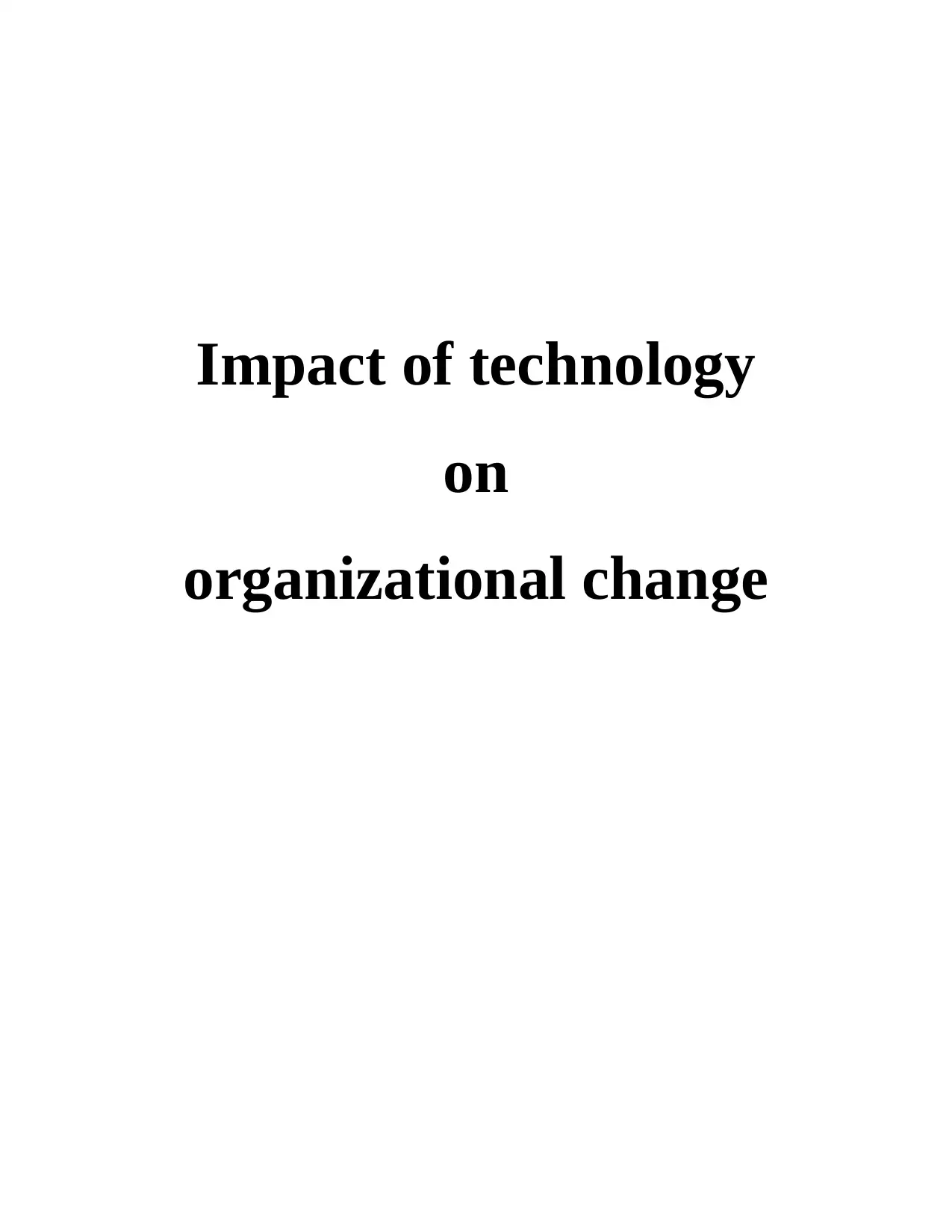
Impact of technology
on
organizational change
on
organizational change
Paraphrase This Document
Need a fresh take? Get an instant paraphrase of this document with our AI Paraphraser
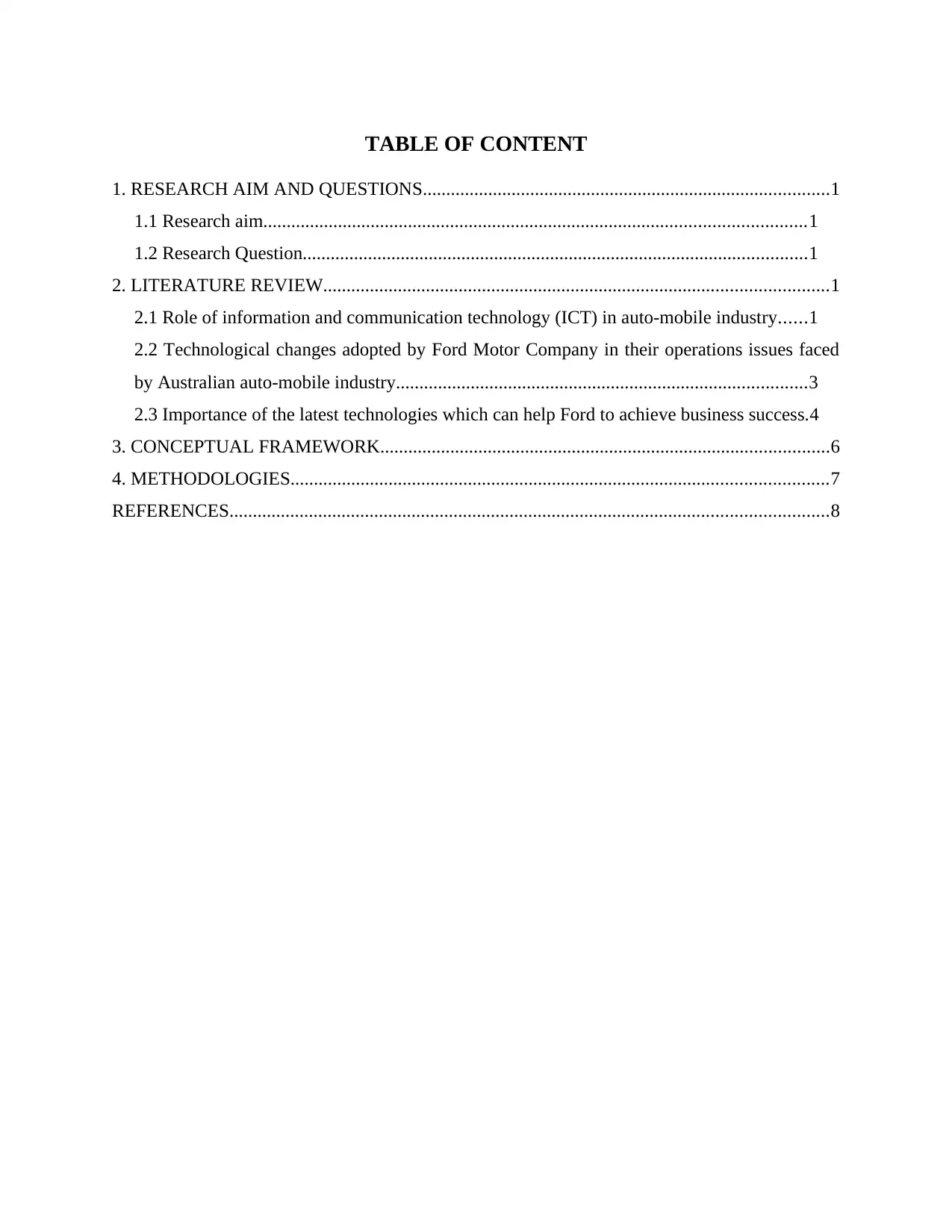
TABLE OF CONTENT
1. RESEARCH AIM AND QUESTIONS.......................................................................................1
1.1 Research aim....................................................................................................................1
1.2 Research Question............................................................................................................1
2. LITERATURE REVIEW............................................................................................................1
2.1 Role of information and communication technology (ICT) in auto-mobile industry......1
2.2 Technological changes adopted by Ford Motor Company in their operations issues faced
by Australian auto-mobile industry........................................................................................3
2.3 Importance of the latest technologies which can help Ford to achieve business success.4
3. CONCEPTUAL FRAMEWORK................................................................................................6
4. METHODOLOGIES...................................................................................................................7
REFERENCES................................................................................................................................8
1. RESEARCH AIM AND QUESTIONS.......................................................................................1
1.1 Research aim....................................................................................................................1
1.2 Research Question............................................................................................................1
2. LITERATURE REVIEW............................................................................................................1
2.1 Role of information and communication technology (ICT) in auto-mobile industry......1
2.2 Technological changes adopted by Ford Motor Company in their operations issues faced
by Australian auto-mobile industry........................................................................................3
2.3 Importance of the latest technologies which can help Ford to achieve business success.4
3. CONCEPTUAL FRAMEWORK................................................................................................6
4. METHODOLOGIES...................................................................................................................7
REFERENCES................................................................................................................................8
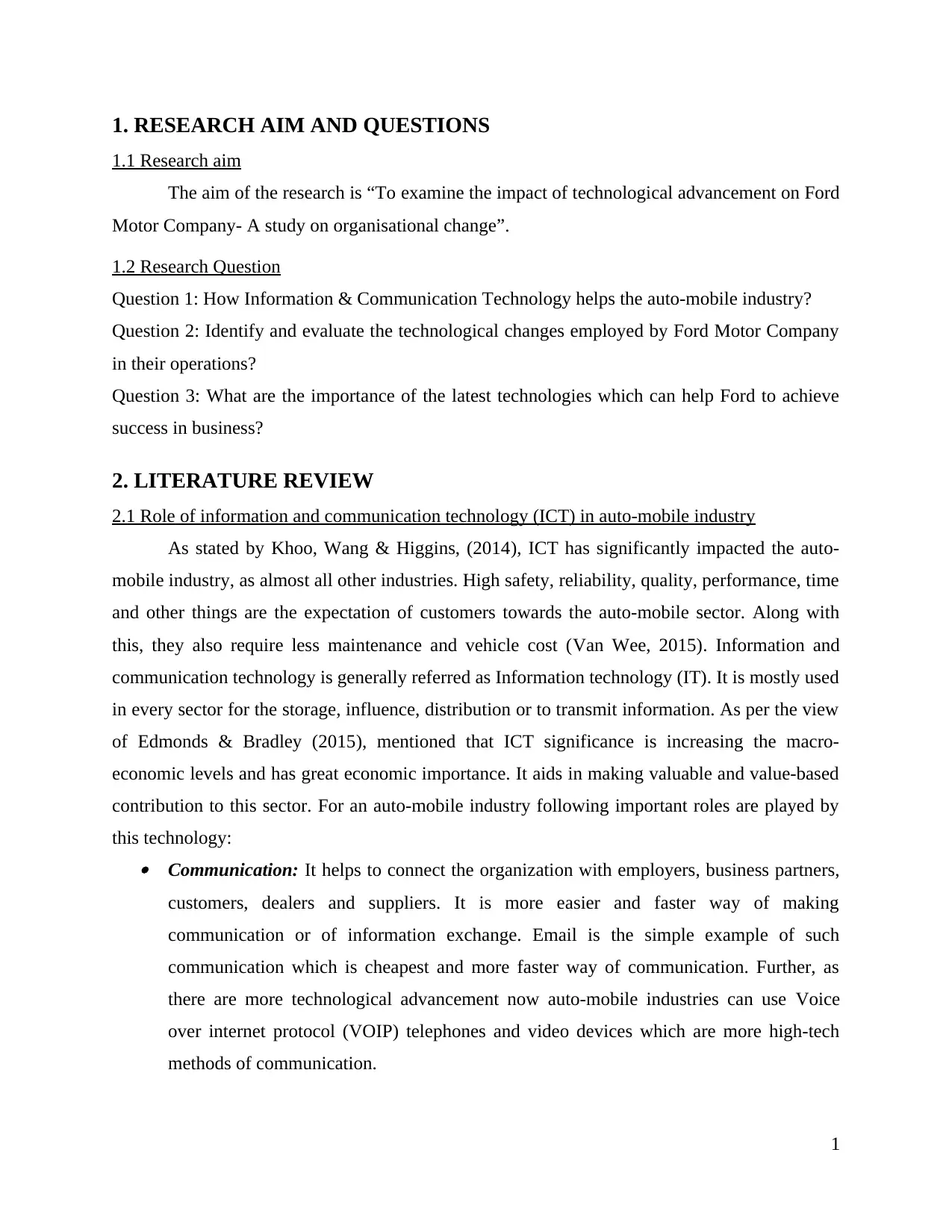
1. RESEARCH AIM AND QUESTIONS
1.1 Research aim
The aim of the research is “To examine the impact of technological advancement on Ford
Motor Company- A study on organisational change”.
1.2 Research Question
Question 1: How Information & Communication Technology helps the auto-mobile industry?
Question 2: Identify and evaluate the technological changes employed by Ford Motor Company
in their operations?
Question 3: What are the importance of the latest technologies which can help Ford to achieve
success in business?
2. LITERATURE REVIEW
2.1 Role of information and communication technology (ICT) in auto-mobile industry
As stated by Khoo, Wang & Higgins, (2014), ICT has significantly impacted the auto-
mobile industry, as almost all other industries. High safety, reliability, quality, performance, time
and other things are the expectation of customers towards the auto-mobile sector. Along with
this, they also require less maintenance and vehicle cost (Van Wee, 2015). Information and
communication technology is generally referred as Information technology (IT). It is mostly used
in every sector for the storage, influence, distribution or to transmit information. As per the view
of Edmonds & Bradley (2015), mentioned that ICT significance is increasing the macro-
economic levels and has great economic importance. It aids in making valuable and value-based
contribution to this sector. For an auto-mobile industry following important roles are played by
this technology: Communication: It helps to connect the organization with employers, business partners,
customers, dealers and suppliers. It is more easier and faster way of making
communication or of information exchange. Email is the simple example of such
communication which is cheapest and more faster way of communication. Further, as
there are more technological advancement now auto-mobile industries can use Voice
over internet protocol (VOIP) telephones and video devices which are more high-tech
methods of communication.
1
1.1 Research aim
The aim of the research is “To examine the impact of technological advancement on Ford
Motor Company- A study on organisational change”.
1.2 Research Question
Question 1: How Information & Communication Technology helps the auto-mobile industry?
Question 2: Identify and evaluate the technological changes employed by Ford Motor Company
in their operations?
Question 3: What are the importance of the latest technologies which can help Ford to achieve
success in business?
2. LITERATURE REVIEW
2.1 Role of information and communication technology (ICT) in auto-mobile industry
As stated by Khoo, Wang & Higgins, (2014), ICT has significantly impacted the auto-
mobile industry, as almost all other industries. High safety, reliability, quality, performance, time
and other things are the expectation of customers towards the auto-mobile sector. Along with
this, they also require less maintenance and vehicle cost (Van Wee, 2015). Information and
communication technology is generally referred as Information technology (IT). It is mostly used
in every sector for the storage, influence, distribution or to transmit information. As per the view
of Edmonds & Bradley (2015), mentioned that ICT significance is increasing the macro-
economic levels and has great economic importance. It aids in making valuable and value-based
contribution to this sector. For an auto-mobile industry following important roles are played by
this technology: Communication: It helps to connect the organization with employers, business partners,
customers, dealers and suppliers. It is more easier and faster way of making
communication or of information exchange. Email is the simple example of such
communication which is cheapest and more faster way of communication. Further, as
there are more technological advancement now auto-mobile industries can use Voice
over internet protocol (VOIP) telephones and video devices which are more high-tech
methods of communication.
1
⊘ This is a preview!⊘
Do you want full access?
Subscribe today to unlock all pages.

Trusted by 1+ million students worldwide
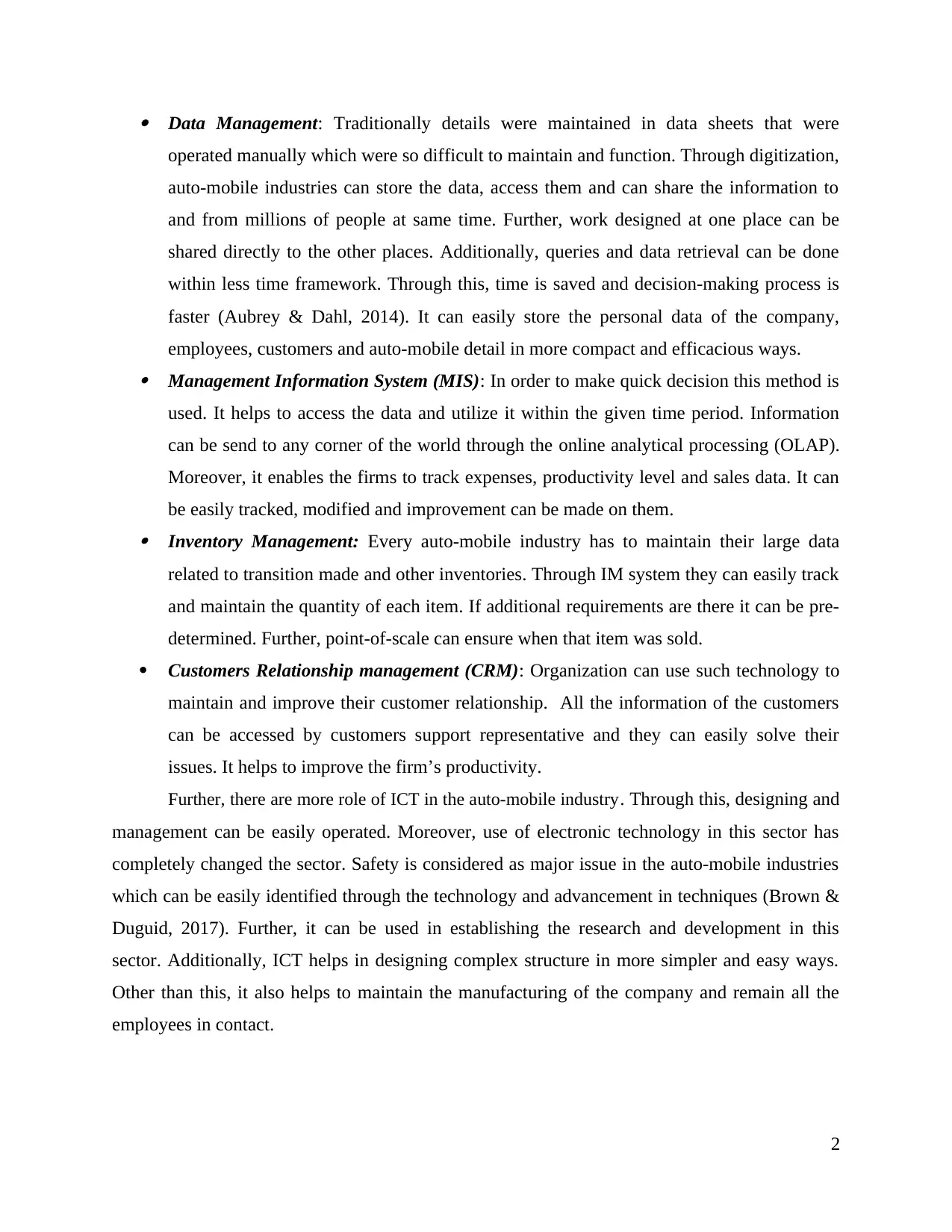
Data Management: Traditionally details were maintained in data sheets that were
operated manually which were so difficult to maintain and function. Through digitization,
auto-mobile industries can store the data, access them and can share the information to
and from millions of people at same time. Further, work designed at one place can be
shared directly to the other places. Additionally, queries and data retrieval can be done
within less time framework. Through this, time is saved and decision-making process is
faster (Aubrey & Dahl, 2014). It can easily store the personal data of the company,
employees, customers and auto-mobile detail in more compact and efficacious ways. Management Information System (MIS): In order to make quick decision this method is
used. It helps to access the data and utilize it within the given time period. Information
can be send to any corner of the world through the online analytical processing (OLAP).
Moreover, it enables the firms to track expenses, productivity level and sales data. It can
be easily tracked, modified and improvement can be made on them. Inventory Management: Every auto-mobile industry has to maintain their large data
related to transition made and other inventories. Through IM system they can easily track
and maintain the quantity of each item. If additional requirements are there it can be pre-
determined. Further, point-of-scale can ensure when that item was sold.
Customers Relationship management (CRM): Organization can use such technology to
maintain and improve their customer relationship. All the information of the customers
can be accessed by customers support representative and they can easily solve their
issues. It helps to improve the firm’s productivity.
Further, there are more role of ICT in the auto-mobile industry. Through this, designing and
management can be easily operated. Moreover, use of electronic technology in this sector has
completely changed the sector. Safety is considered as major issue in the auto-mobile industries
which can be easily identified through the technology and advancement in techniques (Brown &
Duguid, 2017). Further, it can be used in establishing the research and development in this
sector. Additionally, ICT helps in designing complex structure in more simpler and easy ways.
Other than this, it also helps to maintain the manufacturing of the company and remain all the
employees in contact.
2
operated manually which were so difficult to maintain and function. Through digitization,
auto-mobile industries can store the data, access them and can share the information to
and from millions of people at same time. Further, work designed at one place can be
shared directly to the other places. Additionally, queries and data retrieval can be done
within less time framework. Through this, time is saved and decision-making process is
faster (Aubrey & Dahl, 2014). It can easily store the personal data of the company,
employees, customers and auto-mobile detail in more compact and efficacious ways. Management Information System (MIS): In order to make quick decision this method is
used. It helps to access the data and utilize it within the given time period. Information
can be send to any corner of the world through the online analytical processing (OLAP).
Moreover, it enables the firms to track expenses, productivity level and sales data. It can
be easily tracked, modified and improvement can be made on them. Inventory Management: Every auto-mobile industry has to maintain their large data
related to transition made and other inventories. Through IM system they can easily track
and maintain the quantity of each item. If additional requirements are there it can be pre-
determined. Further, point-of-scale can ensure when that item was sold.
Customers Relationship management (CRM): Organization can use such technology to
maintain and improve their customer relationship. All the information of the customers
can be accessed by customers support representative and they can easily solve their
issues. It helps to improve the firm’s productivity.
Further, there are more role of ICT in the auto-mobile industry. Through this, designing and
management can be easily operated. Moreover, use of electronic technology in this sector has
completely changed the sector. Safety is considered as major issue in the auto-mobile industries
which can be easily identified through the technology and advancement in techniques (Brown &
Duguid, 2017). Further, it can be used in establishing the research and development in this
sector. Additionally, ICT helps in designing complex structure in more simpler and easy ways.
Other than this, it also helps to maintain the manufacturing of the company and remain all the
employees in contact.
2
Paraphrase This Document
Need a fresh take? Get an instant paraphrase of this document with our AI Paraphraser
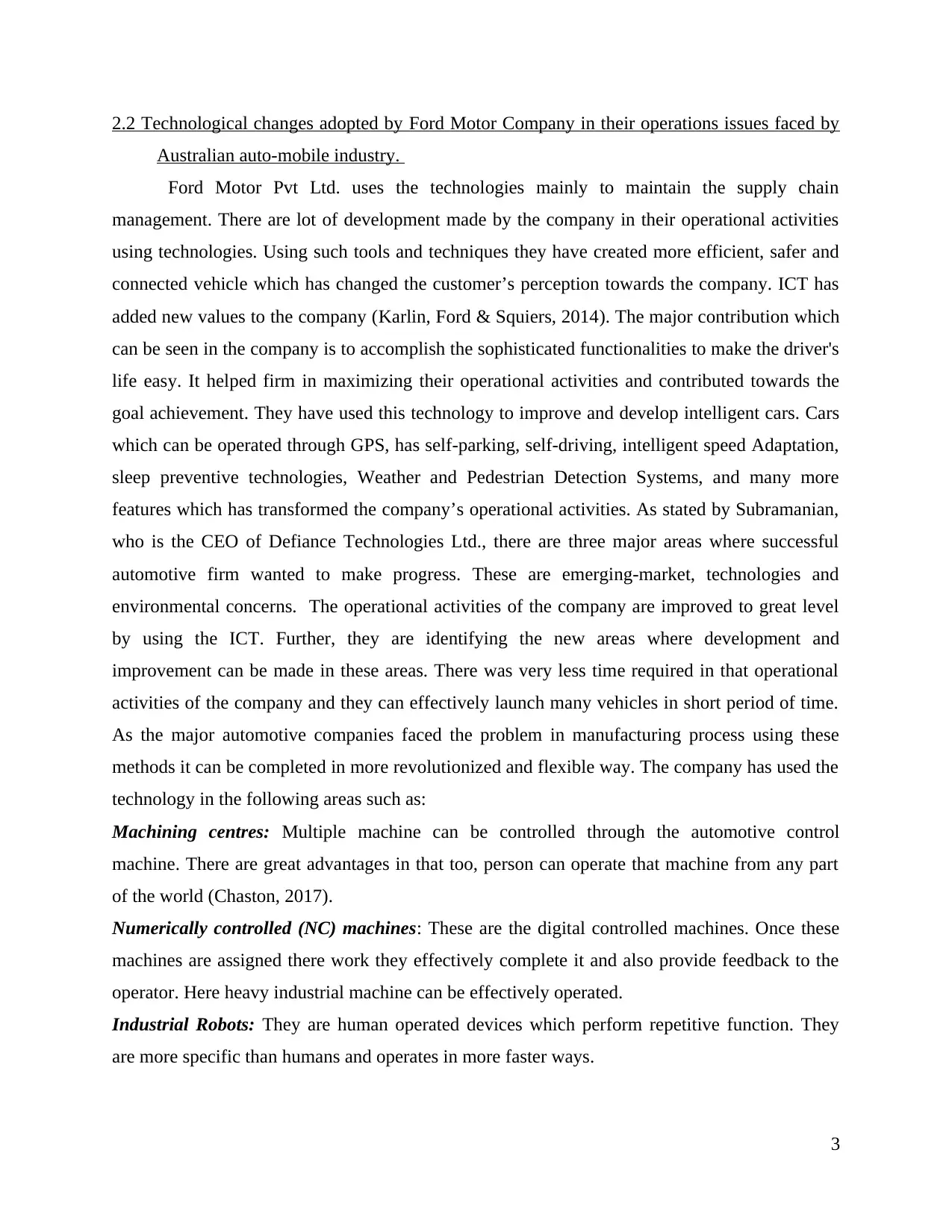
2.2 Technological changes adopted by Ford Motor Company in their operations issues faced by
Australian auto-mobile industry.
Ford Motor Pvt Ltd. uses the technologies mainly to maintain the supply chain
management. There are lot of development made by the company in their operational activities
using technologies. Using such tools and techniques they have created more efficient, safer and
connected vehicle which has changed the customer’s perception towards the company. ICT has
added new values to the company (Karlin, Ford & Squiers, 2014). The major contribution which
can be seen in the company is to accomplish the sophisticated functionalities to make the driver's
life easy. It helped firm in maximizing their operational activities and contributed towards the
goal achievement. They have used this technology to improve and develop intelligent cars. Cars
which can be operated through GPS, has self-parking, self-driving, intelligent speed Adaptation,
sleep preventive technologies, Weather and Pedestrian Detection Systems, and many more
features which has transformed the company’s operational activities. As stated by Subramanian,
who is the CEO of Defiance Technologies Ltd., there are three major areas where successful
automotive firm wanted to make progress. These are emerging-market, technologies and
environmental concerns. The operational activities of the company are improved to great level
by using the ICT. Further, they are identifying the new areas where development and
improvement can be made in these areas. There was very less time required in that operational
activities of the company and they can effectively launch many vehicles in short period of time.
As the major automotive companies faced the problem in manufacturing process using these
methods it can be completed in more revolutionized and flexible way. The company has used the
technology in the following areas such as:
Machining centres: Multiple machine can be controlled through the automotive control
machine. There are great advantages in that too, person can operate that machine from any part
of the world (Chaston, 2017).
Numerically controlled (NC) machines: These are the digital controlled machines. Once these
machines are assigned there work they effectively complete it and also provide feedback to the
operator. Here heavy industrial machine can be effectively operated.
Industrial Robots: They are human operated devices which perform repetitive function. They
are more specific than humans and operates in more faster ways.
3
Australian auto-mobile industry.
Ford Motor Pvt Ltd. uses the technologies mainly to maintain the supply chain
management. There are lot of development made by the company in their operational activities
using technologies. Using such tools and techniques they have created more efficient, safer and
connected vehicle which has changed the customer’s perception towards the company. ICT has
added new values to the company (Karlin, Ford & Squiers, 2014). The major contribution which
can be seen in the company is to accomplish the sophisticated functionalities to make the driver's
life easy. It helped firm in maximizing their operational activities and contributed towards the
goal achievement. They have used this technology to improve and develop intelligent cars. Cars
which can be operated through GPS, has self-parking, self-driving, intelligent speed Adaptation,
sleep preventive technologies, Weather and Pedestrian Detection Systems, and many more
features which has transformed the company’s operational activities. As stated by Subramanian,
who is the CEO of Defiance Technologies Ltd., there are three major areas where successful
automotive firm wanted to make progress. These are emerging-market, technologies and
environmental concerns. The operational activities of the company are improved to great level
by using the ICT. Further, they are identifying the new areas where development and
improvement can be made in these areas. There was very less time required in that operational
activities of the company and they can effectively launch many vehicles in short period of time.
As the major automotive companies faced the problem in manufacturing process using these
methods it can be completed in more revolutionized and flexible way. The company has used the
technology in the following areas such as:
Machining centres: Multiple machine can be controlled through the automotive control
machine. There are great advantages in that too, person can operate that machine from any part
of the world (Chaston, 2017).
Numerically controlled (NC) machines: These are the digital controlled machines. Once these
machines are assigned there work they effectively complete it and also provide feedback to the
operator. Here heavy industrial machine can be effectively operated.
Industrial Robots: They are human operated devices which perform repetitive function. They
are more specific than humans and operates in more faster ways.
3
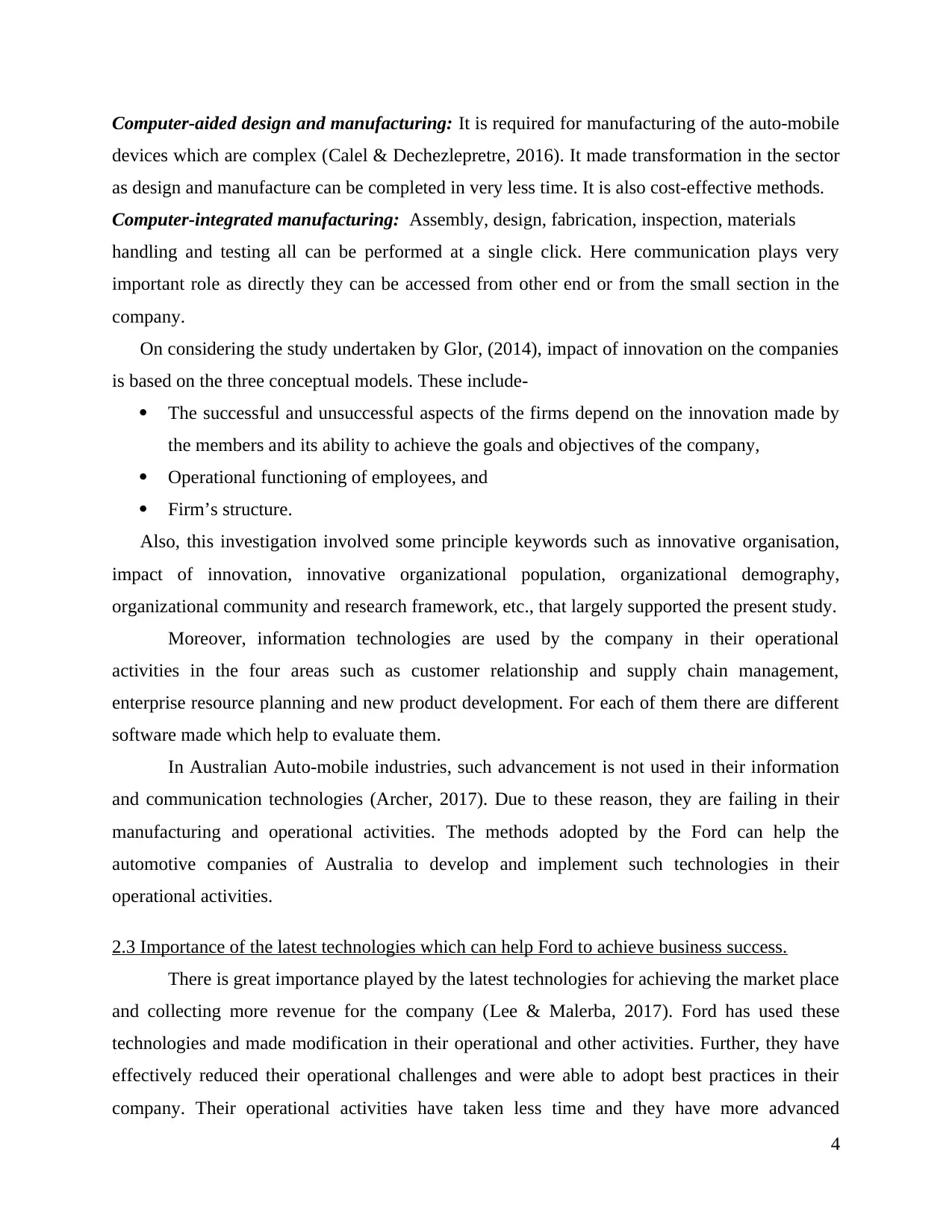
Computer-aided design and manufacturing: It is required for manufacturing of the auto-mobile
devices which are complex (Calel & Dechezlepretre, 2016). It made transformation in the sector
as design and manufacture can be completed in very less time. It is also cost-effective methods.
Computer-integrated manufacturing: Assembly, design, fabrication, inspection, materials
handling and testing all can be performed at a single click. Here communication plays very
important role as directly they can be accessed from other end or from the small section in the
company.
On considering the study undertaken by Glor, (2014), impact of innovation on the companies
is based on the three conceptual models. These include-
The successful and unsuccessful aspects of the firms depend on the innovation made by
the members and its ability to achieve the goals and objectives of the company,
Operational functioning of employees, and
Firm’s structure.
Also, this investigation involved some principle keywords such as innovative organisation,
impact of innovation, innovative organizational population, organizational demography,
organizational community and research framework, etc., that largely supported the present study.
Moreover, information technologies are used by the company in their operational
activities in the four areas such as customer relationship and supply chain management,
enterprise resource planning and new product development. For each of them there are different
software made which help to evaluate them.
In Australian Auto-mobile industries, such advancement is not used in their information
and communication technologies (Archer, 2017). Due to these reason, they are failing in their
manufacturing and operational activities. The methods adopted by the Ford can help the
automotive companies of Australia to develop and implement such technologies in their
operational activities.
2.3 Importance of the latest technologies which can help Ford to achieve business success.
There is great importance played by the latest technologies for achieving the market place
and collecting more revenue for the company (Lee & Malerba, 2017). Ford has used these
technologies and made modification in their operational and other activities. Further, they have
effectively reduced their operational challenges and were able to adopt best practices in their
company. Their operational activities have taken less time and they have more advanced
4
devices which are complex (Calel & Dechezlepretre, 2016). It made transformation in the sector
as design and manufacture can be completed in very less time. It is also cost-effective methods.
Computer-integrated manufacturing: Assembly, design, fabrication, inspection, materials
handling and testing all can be performed at a single click. Here communication plays very
important role as directly they can be accessed from other end or from the small section in the
company.
On considering the study undertaken by Glor, (2014), impact of innovation on the companies
is based on the three conceptual models. These include-
The successful and unsuccessful aspects of the firms depend on the innovation made by
the members and its ability to achieve the goals and objectives of the company,
Operational functioning of employees, and
Firm’s structure.
Also, this investigation involved some principle keywords such as innovative organisation,
impact of innovation, innovative organizational population, organizational demography,
organizational community and research framework, etc., that largely supported the present study.
Moreover, information technologies are used by the company in their operational
activities in the four areas such as customer relationship and supply chain management,
enterprise resource planning and new product development. For each of them there are different
software made which help to evaluate them.
In Australian Auto-mobile industries, such advancement is not used in their information
and communication technologies (Archer, 2017). Due to these reason, they are failing in their
manufacturing and operational activities. The methods adopted by the Ford can help the
automotive companies of Australia to develop and implement such technologies in their
operational activities.
2.3 Importance of the latest technologies which can help Ford to achieve business success.
There is great importance played by the latest technologies for achieving the market place
and collecting more revenue for the company (Lee & Malerba, 2017). Ford has used these
technologies and made modification in their operational and other activities. Further, they have
effectively reduced their operational challenges and were able to adopt best practices in their
company. Their operational activities have taken less time and they have more advanced
4
⊘ This is a preview!⊘
Do you want full access?
Subscribe today to unlock all pages.

Trusted by 1+ million students worldwide
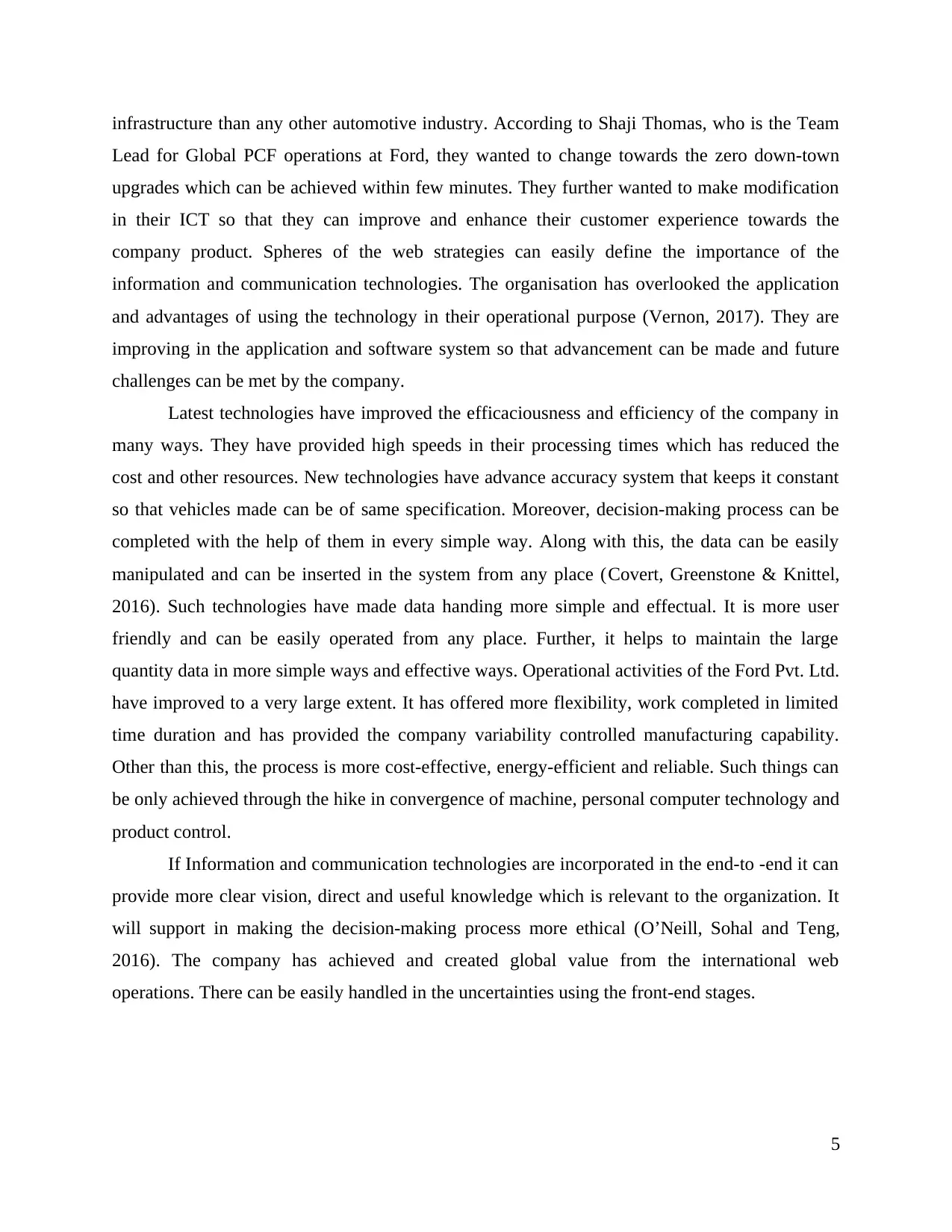
infrastructure than any other automotive industry. According to Shaji Thomas, who is the Team
Lead for Global PCF operations at Ford, they wanted to change towards the zero down-town
upgrades which can be achieved within few minutes. They further wanted to make modification
in their ICT so that they can improve and enhance their customer experience towards the
company product. Spheres of the web strategies can easily define the importance of the
information and communication technologies. The organisation has overlooked the application
and advantages of using the technology in their operational purpose (Vernon, 2017). They are
improving in the application and software system so that advancement can be made and future
challenges can be met by the company.
Latest technologies have improved the efficaciousness and efficiency of the company in
many ways. They have provided high speeds in their processing times which has reduced the
cost and other resources. New technologies have advance accuracy system that keeps it constant
so that vehicles made can be of same specification. Moreover, decision-making process can be
completed with the help of them in every simple way. Along with this, the data can be easily
manipulated and can be inserted in the system from any place (Covert, Greenstone & Knittel,
2016). Such technologies have made data handing more simple and effectual. It is more user
friendly and can be easily operated from any place. Further, it helps to maintain the large
quantity data in more simple ways and effective ways. Operational activities of the Ford Pvt. Ltd.
have improved to a very large extent. It has offered more flexibility, work completed in limited
time duration and has provided the company variability controlled manufacturing capability.
Other than this, the process is more cost-effective, energy-efficient and reliable. Such things can
be only achieved through the hike in convergence of machine, personal computer technology and
product control.
If Information and communication technologies are incorporated in the end-to -end it can
provide more clear vision, direct and useful knowledge which is relevant to the organization. It
will support in making the decision-making process more ethical (O’Neill, Sohal and Teng,
2016). The company has achieved and created global value from the international web
operations. There can be easily handled in the uncertainties using the front-end stages.
5
Lead for Global PCF operations at Ford, they wanted to change towards the zero down-town
upgrades which can be achieved within few minutes. They further wanted to make modification
in their ICT so that they can improve and enhance their customer experience towards the
company product. Spheres of the web strategies can easily define the importance of the
information and communication technologies. The organisation has overlooked the application
and advantages of using the technology in their operational purpose (Vernon, 2017). They are
improving in the application and software system so that advancement can be made and future
challenges can be met by the company.
Latest technologies have improved the efficaciousness and efficiency of the company in
many ways. They have provided high speeds in their processing times which has reduced the
cost and other resources. New technologies have advance accuracy system that keeps it constant
so that vehicles made can be of same specification. Moreover, decision-making process can be
completed with the help of them in every simple way. Along with this, the data can be easily
manipulated and can be inserted in the system from any place (Covert, Greenstone & Knittel,
2016). Such technologies have made data handing more simple and effectual. It is more user
friendly and can be easily operated from any place. Further, it helps to maintain the large
quantity data in more simple ways and effective ways. Operational activities of the Ford Pvt. Ltd.
have improved to a very large extent. It has offered more flexibility, work completed in limited
time duration and has provided the company variability controlled manufacturing capability.
Other than this, the process is more cost-effective, energy-efficient and reliable. Such things can
be only achieved through the hike in convergence of machine, personal computer technology and
product control.
If Information and communication technologies are incorporated in the end-to -end it can
provide more clear vision, direct and useful knowledge which is relevant to the organization. It
will support in making the decision-making process more ethical (O’Neill, Sohal and Teng,
2016). The company has achieved and created global value from the international web
operations. There can be easily handled in the uncertainties using the front-end stages.
5
Paraphrase This Document
Need a fresh take? Get an instant paraphrase of this document with our AI Paraphraser
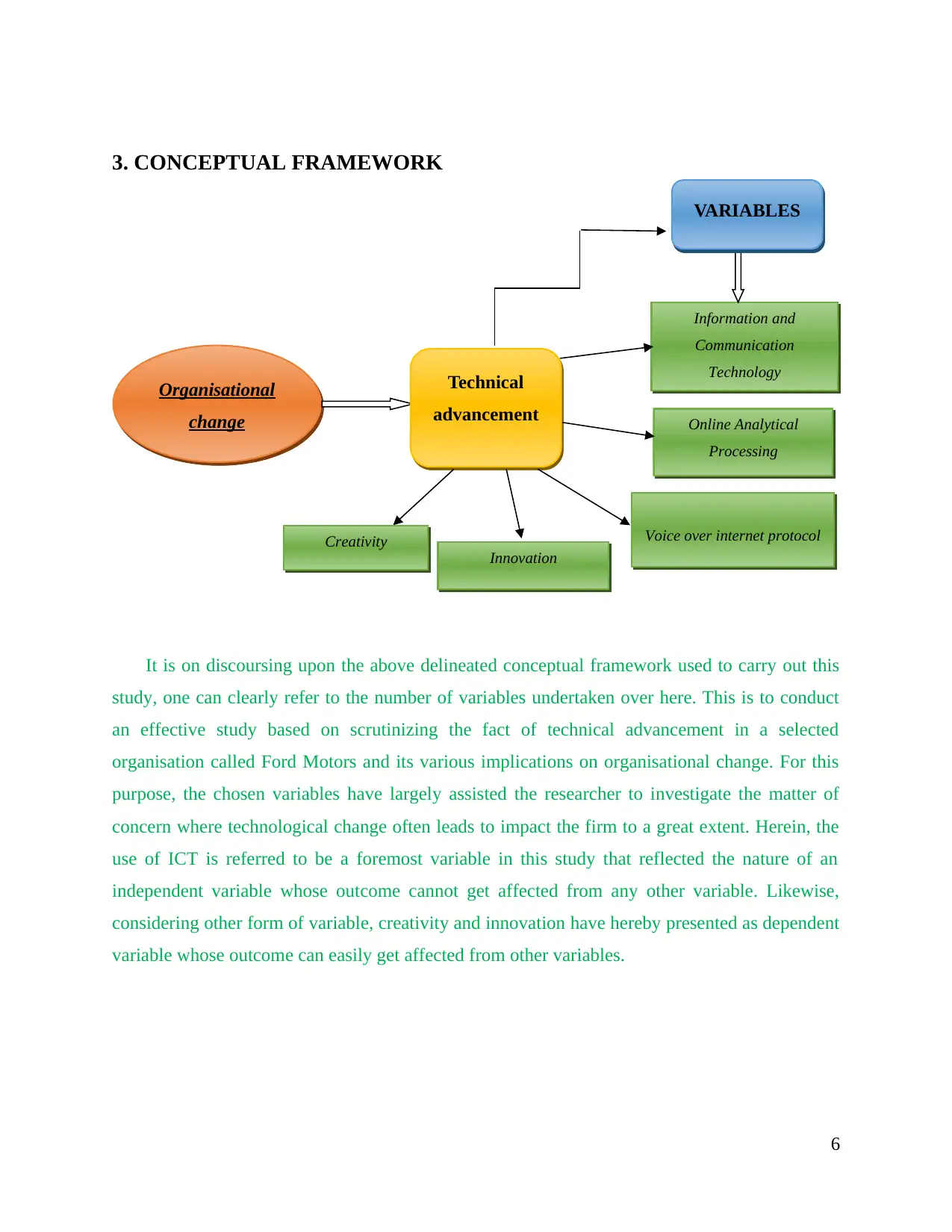
3. CONCEPTUAL FRAMEWORK
It is on discoursing upon the above delineated conceptual framework used to carry out this
study, one can clearly refer to the number of variables undertaken over here. This is to conduct
an effective study based on scrutinizing the fact of technical advancement in a selected
organisation called Ford Motors and its various implications on organisational change. For this
purpose, the chosen variables have largely assisted the researcher to investigate the matter of
concern where technological change often leads to impact the firm to a great extent. Herein, the
use of ICT is referred to be a foremost variable in this study that reflected the nature of an
independent variable whose outcome cannot get affected from any other variable. Likewise,
considering other form of variable, creativity and innovation have hereby presented as dependent
variable whose outcome can easily get affected from other variables.
6
Organisational
change
Technical
advancement
Information and
Communication
Technology
Online Analytical
Processing
Voice over internet protocol
VARIABLES
Innovation
Creativity
It is on discoursing upon the above delineated conceptual framework used to carry out this
study, one can clearly refer to the number of variables undertaken over here. This is to conduct
an effective study based on scrutinizing the fact of technical advancement in a selected
organisation called Ford Motors and its various implications on organisational change. For this
purpose, the chosen variables have largely assisted the researcher to investigate the matter of
concern where technological change often leads to impact the firm to a great extent. Herein, the
use of ICT is referred to be a foremost variable in this study that reflected the nature of an
independent variable whose outcome cannot get affected from any other variable. Likewise,
considering other form of variable, creativity and innovation have hereby presented as dependent
variable whose outcome can easily get affected from other variables.
6
Organisational
change
Technical
advancement
Information and
Communication
Technology
Online Analytical
Processing
Voice over internet protocol
VARIABLES
Innovation
Creativity
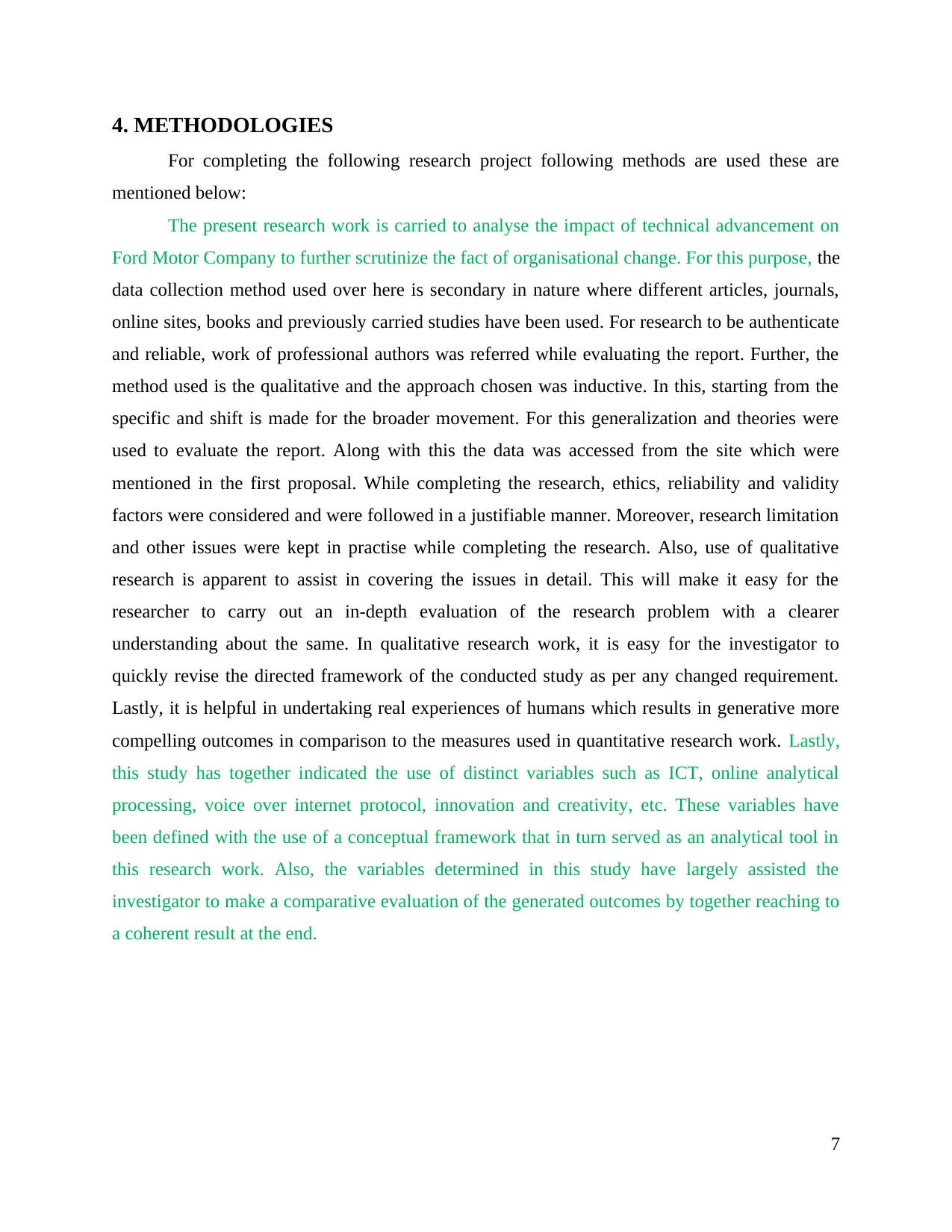
4. METHODOLOGIES
For completing the following research project following methods are used these are
mentioned below:
The present research work is carried to analyse the impact of technical advancement on
Ford Motor Company to further scrutinize the fact of organisational change. For this purpose, the
data collection method used over here is secondary in nature where different articles, journals,
online sites, books and previously carried studies have been used. For research to be authenticate
and reliable, work of professional authors was referred while evaluating the report. Further, the
method used is the qualitative and the approach chosen was inductive. In this, starting from the
specific and shift is made for the broader movement. For this generalization and theories were
used to evaluate the report. Along with this the data was accessed from the site which were
mentioned in the first proposal. While completing the research, ethics, reliability and validity
factors were considered and were followed in a justifiable manner. Moreover, research limitation
and other issues were kept in practise while completing the research. Also, use of qualitative
research is apparent to assist in covering the issues in detail. This will make it easy for the
researcher to carry out an in-depth evaluation of the research problem with a clearer
understanding about the same. In qualitative research work, it is easy for the investigator to
quickly revise the directed framework of the conducted study as per any changed requirement.
Lastly, it is helpful in undertaking real experiences of humans which results in generative more
compelling outcomes in comparison to the measures used in quantitative research work. Lastly,
this study has together indicated the use of distinct variables such as ICT, online analytical
processing, voice over internet protocol, innovation and creativity, etc. These variables have
been defined with the use of a conceptual framework that in turn served as an analytical tool in
this research work. Also, the variables determined in this study have largely assisted the
investigator to make a comparative evaluation of the generated outcomes by together reaching to
a coherent result at the end.
7
For completing the following research project following methods are used these are
mentioned below:
The present research work is carried to analyse the impact of technical advancement on
Ford Motor Company to further scrutinize the fact of organisational change. For this purpose, the
data collection method used over here is secondary in nature where different articles, journals,
online sites, books and previously carried studies have been used. For research to be authenticate
and reliable, work of professional authors was referred while evaluating the report. Further, the
method used is the qualitative and the approach chosen was inductive. In this, starting from the
specific and shift is made for the broader movement. For this generalization and theories were
used to evaluate the report. Along with this the data was accessed from the site which were
mentioned in the first proposal. While completing the research, ethics, reliability and validity
factors were considered and were followed in a justifiable manner. Moreover, research limitation
and other issues were kept in practise while completing the research. Also, use of qualitative
research is apparent to assist in covering the issues in detail. This will make it easy for the
researcher to carry out an in-depth evaluation of the research problem with a clearer
understanding about the same. In qualitative research work, it is easy for the investigator to
quickly revise the directed framework of the conducted study as per any changed requirement.
Lastly, it is helpful in undertaking real experiences of humans which results in generative more
compelling outcomes in comparison to the measures used in quantitative research work. Lastly,
this study has together indicated the use of distinct variables such as ICT, online analytical
processing, voice over internet protocol, innovation and creativity, etc. These variables have
been defined with the use of a conceptual framework that in turn served as an analytical tool in
this research work. Also, the variables determined in this study have largely assisted the
investigator to make a comparative evaluation of the generated outcomes by together reaching to
a coherent result at the end.
7
⊘ This is a preview!⊘
Do you want full access?
Subscribe today to unlock all pages.

Trusted by 1+ million students worldwide
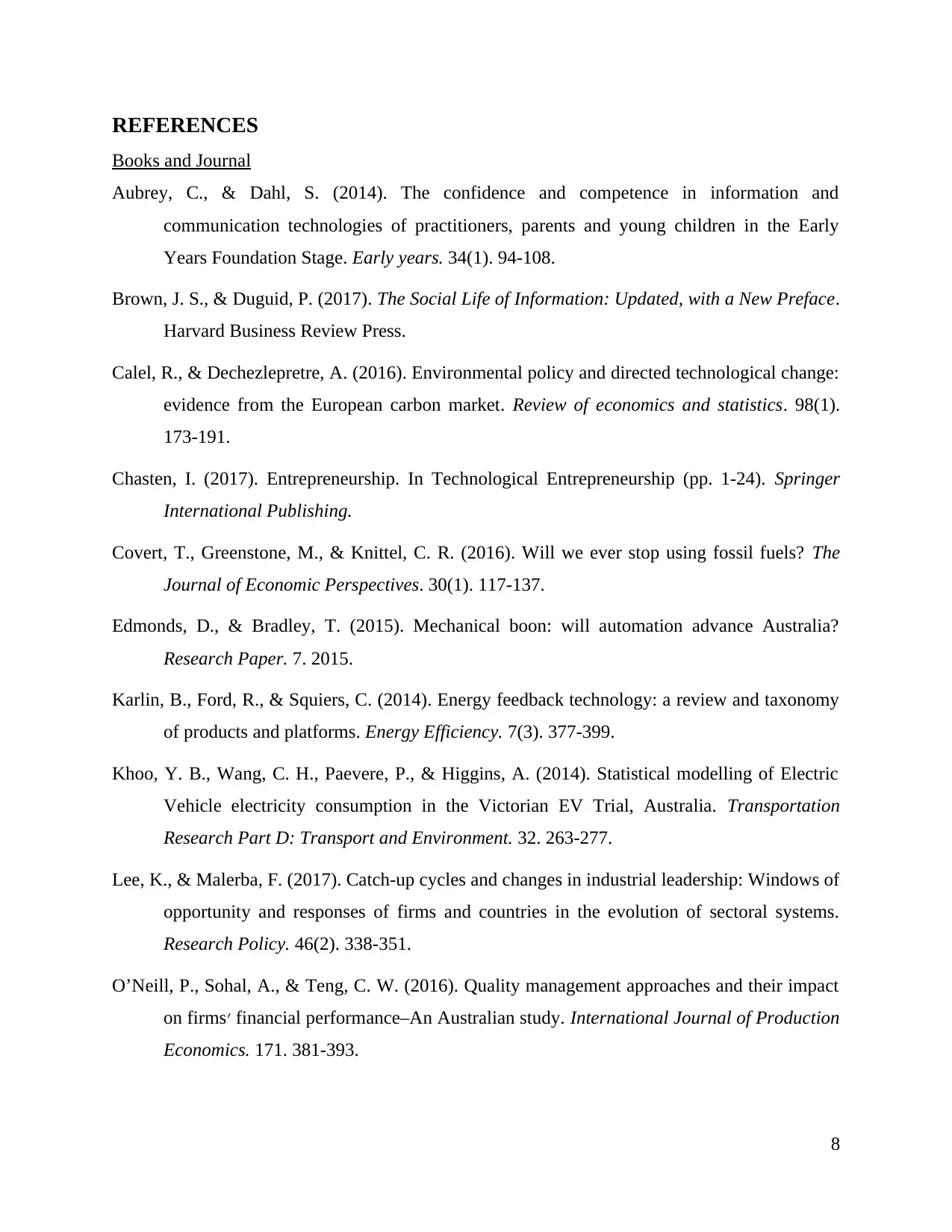
REFERENCES
Books and Journal
Aubrey, C., & Dahl, S. (2014). The confidence and competence in information and
communication technologies of practitioners, parents and young children in the Early
Years Foundation Stage. Early years. 34(1). 94-108.
Brown, J. S., & Duguid, P. (2017). The Social Life of Information: Updated, with a New Preface.
Harvard Business Review Press.
Calel, R., & Dechezlepretre, A. (2016). Environmental policy and directed technological change:
evidence from the European carbon market. Review of economics and statistics. 98(1).
173-191.
Chasten, I. (2017). Entrepreneurship. In Technological Entrepreneurship (pp. 1-24). Springer
International Publishing.
Covert, T., Greenstone, M., & Knittel, C. R. (2016). Will we ever stop using fossil fuels? The
Journal of Economic Perspectives. 30(1). 117-137.
Edmonds, D., & Bradley, T. (2015). Mechanical boon: will automation advance Australia?
Research Paper. 7. 2015.
Karlin, B., Ford, R., & Squiers, C. (2014). Energy feedback technology: a review and taxonomy
of products and platforms. Energy Efficiency. 7(3). 377-399.
Khoo, Y. B., Wang, C. H., Paevere, P., & Higgins, A. (2014). Statistical modelling of Electric
Vehicle electricity consumption in the Victorian EV Trial, Australia. Transportation
Research Part D: Transport and Environment. 32. 263-277.
Lee, K., & Malerba, F. (2017). Catch-up cycles and changes in industrial leadership: Windows of
opportunity and responses of firms and countries in the evolution of sectoral systems.
Research Policy. 46(2). 338-351.
O’Neill, P., Sohal, A., & Teng, C. W. (2016). Quality management approaches and their impact
on firms׳ financial performance–An Australian study. International Journal of Production
Economics. 171. 381-393.
8
Books and Journal
Aubrey, C., & Dahl, S. (2014). The confidence and competence in information and
communication technologies of practitioners, parents and young children in the Early
Years Foundation Stage. Early years. 34(1). 94-108.
Brown, J. S., & Duguid, P. (2017). The Social Life of Information: Updated, with a New Preface.
Harvard Business Review Press.
Calel, R., & Dechezlepretre, A. (2016). Environmental policy and directed technological change:
evidence from the European carbon market. Review of economics and statistics. 98(1).
173-191.
Chasten, I. (2017). Entrepreneurship. In Technological Entrepreneurship (pp. 1-24). Springer
International Publishing.
Covert, T., Greenstone, M., & Knittel, C. R. (2016). Will we ever stop using fossil fuels? The
Journal of Economic Perspectives. 30(1). 117-137.
Edmonds, D., & Bradley, T. (2015). Mechanical boon: will automation advance Australia?
Research Paper. 7. 2015.
Karlin, B., Ford, R., & Squiers, C. (2014). Energy feedback technology: a review and taxonomy
of products and platforms. Energy Efficiency. 7(3). 377-399.
Khoo, Y. B., Wang, C. H., Paevere, P., & Higgins, A. (2014). Statistical modelling of Electric
Vehicle electricity consumption in the Victorian EV Trial, Australia. Transportation
Research Part D: Transport and Environment. 32. 263-277.
Lee, K., & Malerba, F. (2017). Catch-up cycles and changes in industrial leadership: Windows of
opportunity and responses of firms and countries in the evolution of sectoral systems.
Research Policy. 46(2). 338-351.
O’Neill, P., Sohal, A., & Teng, C. W. (2016). Quality management approaches and their impact
on firms׳ financial performance–An Australian study. International Journal of Production
Economics. 171. 381-393.
8
Paraphrase This Document
Need a fresh take? Get an instant paraphrase of this document with our AI Paraphraser
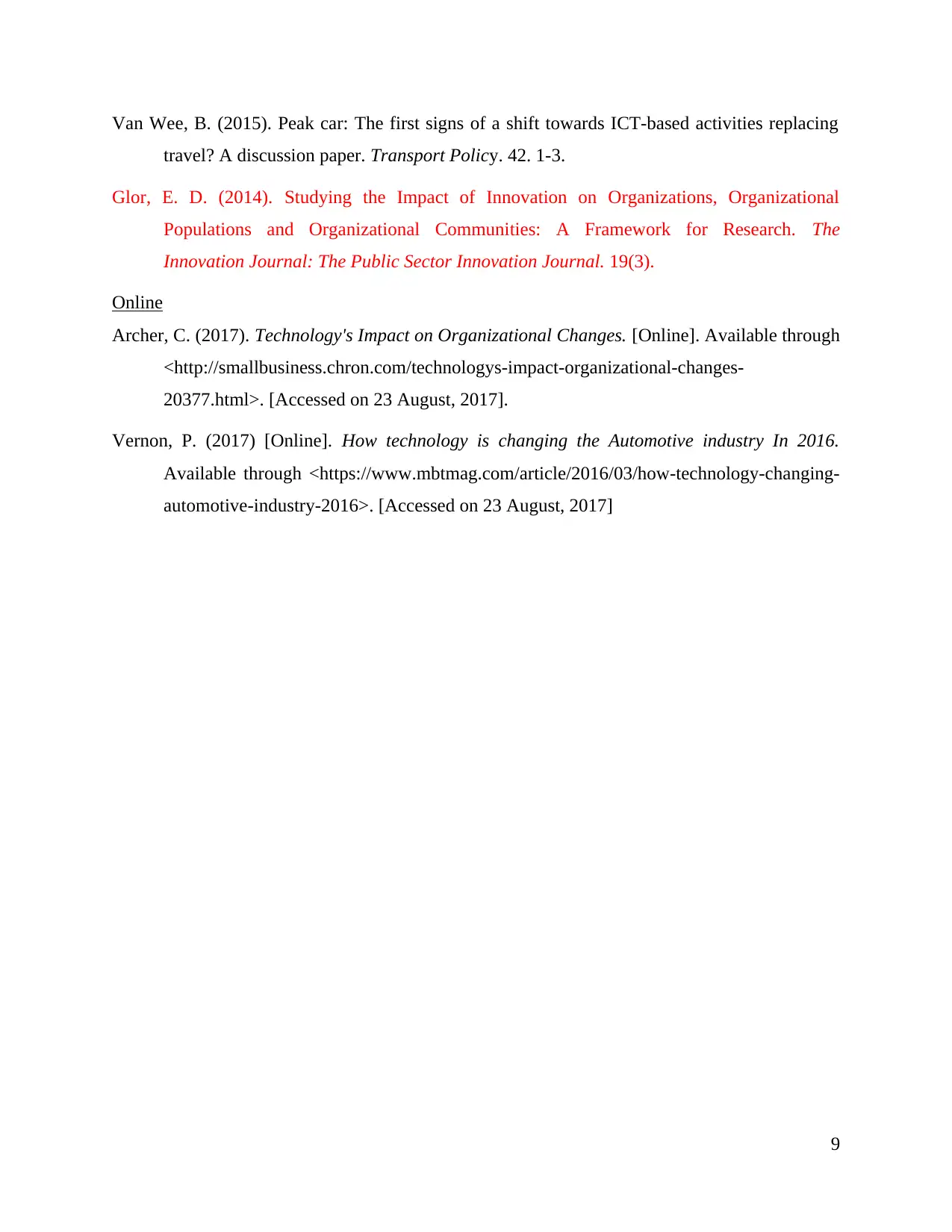
Van Wee, B. (2015). Peak car: The first signs of a shift towards ICT-based activities replacing
travel? A discussion paper. Transport Policy. 42. 1-3.
Glor, E. D. (2014). Studying the Impact of Innovation on Organizations, Organizational
Populations and Organizational Communities: A Framework for Research. The
Innovation Journal: The Public Sector Innovation Journal. 19(3).
Online
Archer, C. (2017). Technology's Impact on Organizational Changes. [Online]. Available through
<http://smallbusiness.chron.com/technologys-impact-organizational-changes-
20377.html>. [Accessed on 23 August, 2017].
Vernon, P. (2017) [Online]. How technology is changing the Automotive industry In 2016.
Available through <https://www.mbtmag.com/article/2016/03/how-technology-changing-
automotive-industry-2016>. [Accessed on 23 August, 2017]
9
travel? A discussion paper. Transport Policy. 42. 1-3.
Glor, E. D. (2014). Studying the Impact of Innovation on Organizations, Organizational
Populations and Organizational Communities: A Framework for Research. The
Innovation Journal: The Public Sector Innovation Journal. 19(3).
Online
Archer, C. (2017). Technology's Impact on Organizational Changes. [Online]. Available through
<http://smallbusiness.chron.com/technologys-impact-organizational-changes-
20377.html>. [Accessed on 23 August, 2017].
Vernon, P. (2017) [Online]. How technology is changing the Automotive industry In 2016.
Available through <https://www.mbtmag.com/article/2016/03/how-technology-changing-
automotive-industry-2016>. [Accessed on 23 August, 2017]
9
1 out of 11
Related Documents
Your All-in-One AI-Powered Toolkit for Academic Success.
+13062052269
info@desklib.com
Available 24*7 on WhatsApp / Email
![[object Object]](/_next/static/media/star-bottom.7253800d.svg)
Unlock your academic potential
Copyright © 2020–2025 A2Z Services. All Rights Reserved. Developed and managed by ZUCOL.





